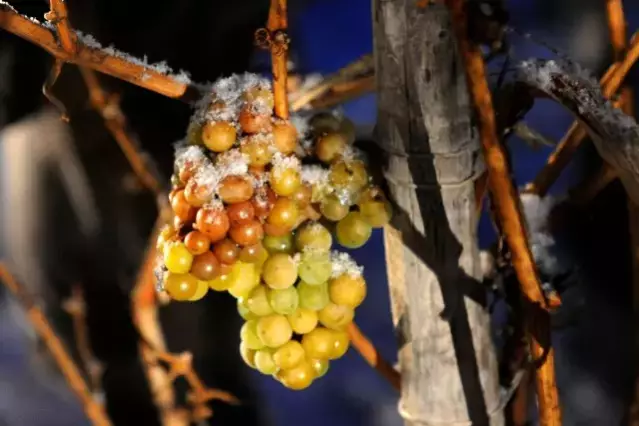Return of winter enables ice wine harvest in a few areas
The return of winter on 8 January with frosty night-time temperatures down to -11° C in some places enabled individual wine producers to harvest again the coveted frozen grapes.

Thus, the Herzer winery from Naumburg/Roßbach in the Saale-Unstrut wine-growing region was able to harvest Pinot Blanc grapes with 185° Oe from the Steinmeister vineyard on an area of around 0.3 hectares in the early hours of the morning in icy -11°C temperatures. "The grapes are still being pressed, but we are expecting around 400 litres of ice wine," says Stephan Herzer happily.
The H. Freiberger winery in Heppenheim on the Hessische Bergstrasse was also delighted with a crowning finale to the 2023 harvest. "At -9°C, we were able to harvest Riesling grapes with around 185° Oe for around 60 - 70 litres of must in the Heppenheimer Stemmler," reports former German wine princess Charlotte Freiberger.
In Sachsen, the employees of the Meißen winegrowers' cooperative are also delighted with a successful ice wine harvest. Frozen grapes of the Cabernet Blanc variety were harvested on 0.3 hectares at a frosty -11°C.
It was also crisp and cold in Iphofen in the district of Kitzingen in Franken where the Ilmbacher Hof winery was able to harvest Silvaner grapes with a high Oechsle value of 208 degrees on Tuesday morning at temperatures of around -8°C. Winemaker Thomas Fröhlich, who was able to harvest healthy grapes for ice wine for the first time, expects a yield of just under 50 litres.
On the Ahr, the Oliver Schell winery in Rech was able to harvest Pinot Noir grapes at 195°Oe in the Möchberg/Mayschoss vineyard at -9°C for the coveted ice wine. Winemaker Oliver Schell estimates that the yield will be around 50 litres of grape must.
In the middle of the week, five members of the Durbach winegrowers in Baden harvested 320 litres of Riesling ice wine at -8°C degrees Celsius. The Häußermann organic winery in Waiblingen also harvested 100 litres of Sauvignon gris at around 160°Oe. The Bernhard Ellwanger winery in Weinstadt harvested Cabernet Cubin grapes at 168°Oe on the Geradstettener Lichtenberg for around 240 litres of sugar-sweet must. Leon Gold's team in Weinstadt was equally successful: Goldmuskateller from the Steingrüble vineyard was harvested at -8.5°C. The same grape variety was also the focus at the Klopfer winery: "We were finally able to bring home our Goldmuskateller in perfect conditions," says Christoph Klopfer happily.
According to the RLP State Examination Office, only one winery in the Pfalz was able to harvest the deeply frozen grapes.
Early ice wine harvest at the beginning of December
The first onset of winter came as early as the beginning of December 2023, allowing winegrowers from Rheinhessen, Württemberg, Franken and the Mosel to harvest ice wine very early. From Württemberg, the Metzingen-Neuhausen winegrowers' cooperative reported a harvest of around 400 kg of grapes or 70 litres of must at 140°Oe and the State Teaching and Research Institute (LVWO) in Weinsberg reported a harvest of 700 kilograms of Riesling ice wine grapes.
The Andreas Braun winery in Volkach, Franken, was able to harvest frozen grapes for around 200 litres of Riesling ice wine in the icy temperatures. On the Mosel, only one winery was successful with 130 litres of Riesling ice wine and in Rheinhessen, four producers were able to harvest Silvaner grapes for ice wine production.
Not without risk - ice wine poker
Ice wine is always associated with a risk for winegrowers. If the temperatures are not cold enough, this often means a total loss for the winegrowers, and in some cases the grapes can still be used as Beerenauslese. As a result, the areas registered for an ice wine harvest have seen a steady decline in recent years.
In Rheinland-Pfalz, 40 wineries registered around 32 hectares for the ice wine harvest this year, compared to just 24 hectares in 2022. In previous years, the figure was 107 hectares (2021) and even more than 500 hectares in 2018. Ice wine is a rarity and demands a lot of skill from the winemaker. "Especially after a difficult autumn, only a few winegrowers dare to take the risk," says Benjamin Petry, viticulture officer at the Rheinland-Pfalz Chamber of Agriculture. For this winter half-year, areas have been registered primarily for Riesling and Silvaner, followed by Gewürztraminer.
Franken, Bayern: Fewer producers rely on ice wine "gamble"
According to information from Franken's winegrower association, fewer and fewer winegrowers in Franconia are also relying on ice wine, as winters are getting warmer and warmer and frosty temperatures often only prevail in January or February. While around 40 wineries were still able to harvest ice wine in 2012, only seven wine producers were able to harvest a total of around 600-700 liters of the coveted grapes in 2022.
Minus seven degrees Celsius
For an ice wine harvest, the grapes must be frozen through. This requires at least minus seven degrees for several hours. The overripe grapes are harvested frozen and pressed.
Noble sweet specialty in demand internationally
The secret of ice wines lies in the dense concentration of ingredients from grapes that are as healthy as possible. In the frosty temperatures, the water in the berries freezes and remains in the wine press. The juice then drips from the press as sweet as honey. Musts with such a high sugar content can only be fermented into wine with great difficulty by the yeasts. Accordingly, ice wines usually have very high natural residual sugar levels of well over 100 grams per liter, but in contrast to southern sweet wines, they only have relatively low alcohol levels - often only around seven percent by volume.
Great international recognition
Another special feature of these fine wines is that this enormous residual sweetness is not overpowering thanks to the fresh fruit acidity. As a rarity and specialty, German ice wines also enjoy great international recognition.

